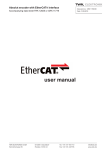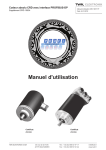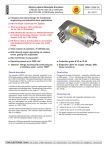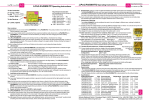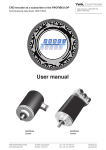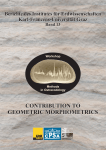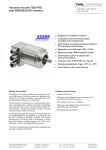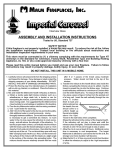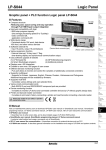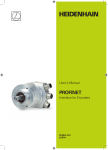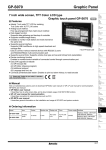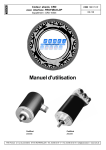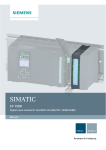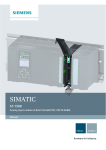Download CRT absolute encoders with PROFINET interface
Transcript
CRT absolute encoders with PROFINET interface Relevant data sheet CRT 11889 Data sheet no.: CRT 11890 CE Date: 03.04.2012 User manual TWK-ELEKTRONIK GmbH Heinrichstrasse 85 D-40041 Düsseldorf Postbox 10 50 63 Tel. +49 211 96117-0 Fax +49 211 637705 [email protected] www.twk.de COPYRIGHT: The CRT 11890 operating instructions are owned by TWK-ELEKTRONIK GMBH and are protected by copyright laws and international treaty provisions. © 2011 by TWK-ELEKTRONIK GMBH POB 10 50 63 ■ 40041 Düsseldorf ■ Germany Tel. +49/211/63 20 67 ■ Fax +49/211/63 77 05 [email protected] ■ www.twk.de Date: 03.04.2012 Page 2 of 29 data sheet no. CRT 11890 CE Table of contents 1. Safety instructions.............................................................................................................. 5 1.1 Scope............................................................................................................................................5 1.2 Documentation..............................................................................................................................5 1.3 Proper use....................................................................................................................................5 1.4 Commissioning.............................................................................................................................5 2. General information............................................................................................................ 6 3. Installation........................................................................................................................... 7 3.1 General information .....................................................................................................................7 3.2 Electrical connection.....................................................................................................................7 3.3 Status LEDs..................................................................................................................................8 3.4 Project planning............................................................................................................................8 4. Project planning with Simatic Step7................................................................................. 9 4.1 Prerequisites.................................................................................................................................9 4.2 Installation of the GSD file............................................................................................................9 4.3 Installing the absolute encoder...................................................................................................10 4.4 Installing the module................................................................................................................... 11 4.5 Setting the network data (CRT properties).................................................................................13 4.6 Setting the absolute encoder (properties of the module)............................................................14 4.6.1 Setting the I/O address.........................................................................................................14 4.6.2 Parameterising the absolute encoder...................................................................................14 4.7 Setting real time mode and the updating time............................................................................15 4.8 Planning of "Device exchange without programming device" and "Automatic commissioning".15 4.9 Assignment of the device name..................................................................................................16 4.10 Resetting to the default settings...............................................................................................17 4.11 Application programme.............................................................................................................18 4.11.1 Position value and preset....................................................................................................18 4.11.2 Reading diagnostic data......................................................................................................19 4.11.3 Writing parameters..............................................................................................................21 5. Data format........................................................................................................................ 23 5.1 Module "Class2, xx bit"...............................................................................................................23 5.2 Module "Class2, position (xx bit) + velocity"...............................................................................23 5.3 Position data...............................................................................................................................23 5.4 Velocity.......................................................................................................................................23 5.5 Setting the reference value (preset value)..................................................................................24 Date: 03.04.2012 Page 3 of 29 data sheet no. CRT 11890 CE Table of contents 6. Parameterisation............................................................................................................... 25 6.1 Overview.....................................................................................................................................25 6.2 Description of the absolute encoder parameters........................................................................25 7. Diagnosis........................................................................................................................... 27 7.1 Overview.....................................................................................................................................27 7.2 Diagnostic data...........................................................................................................................27 7.3 Manufacturer-specific diagnostic data........................................................................................28 8. Scope of delivery............................................................................................................... 29 Annex A: absolute encoder terms....................................................................................... 29 Date: 03.04.2012 Page 4 of 29 data sheet no. CRT 11890 CE Safety instructions 1. Safety instructions 1.1 Scope This user manual is valid exclusively for the following absolute encoders with PROFINET interface: - CRTxx-xxxxRxxxxC4M01 1.2 Documentation The following documents must be observed: - The owner's system-specific operating instructions - This user manual - Data sheet number CRT 11889 - The connection assignment enclosed with the device - Assembly instructions TZY10206 enclosed with the device 1.3 Proper use The TWK-ELEKTRONIK GmbH absolute encoders and linear transducers are used to register angular or linear positions and make their measured value available in the form of an electrical output signal. As part of a system, they have to be connected to the downstream electronics and must only be used for this purpose. 1.4 Commissioning • The relevant device may only be set up and operated in combination with this and the documentation specified under point 1.2. • Protect the device against mechanical damage during installation and operation. • Device commissioning and operation may only be undertaken by a specialist electrician. • Do not operate the device outside of the limit values specified in the data sheet. • Check all electrical connections before commissioning the system. Date: 03.04.2012 Page 5 of 29 data sheet no. CRT 11890 CE General information 2. General information The CRT optoelectronic absolute encoders are designed for direct connection to the industrial Ethernet system PROFINET. The profinet interface according to IEC 61158 / 61784 or PNO specifications Order Nos. 2.712 and 2.722 version 2.3 is integrated. The specifications can be obtained from the profibus user organisation (www.profibus.com). The CRT PROFINET absolute encoder offers the class 2 encoder profile familiar from the CRD profibus absolute encoder. In terms of setting the reference value, parameterisation and diagnosis, handling is therefore identical for the user. From firmware version 2.0 onwards the encoder supports a 16 bit velocity signal in the dimension steps/gating time in addition to the position value. The gating time is adjustable in the range of 10…10000 ms. Date: 03.04.2012 Page 6 of 29 data sheet no. CRT 11890 CE Installation 3. Installation 3.1 General information • During installation, observe the profinet assembly guideline PNO order No.: 8.071 • Use only certified profinet cables, connectors and switches (see "PROFINET Cabling and Interconnection Technology" PNO order No.: 2.252 and "Installation Guideline PROFINET Part 2: Network Components" PNO order No.: 2.252 p2) • Hubs are not permissible. • The cable length between two subscribers may be max. 100 m. • The TWK CRT absolute encoder possesses an integrated switch. This not only enables tree and star topo- logies but also the linear topology. • Media redundancy protocol support enables the establishment of a redundant ring. • The setting of addresses, the baud rate or terminating resistors on the device is not necessary. 3.2 Electrical connection The " ...M01" type absolute encoders have separate connectors for the supply and the PROFINET system. Port 1 or port 2 are optionally available for the PROFINET connection. Due to the integrated switch, it is irrelevant which port is used. Connection Designation Connector type PROFINET Port 1 M12x4 D-coded socket PROFINET Port 2 M12x4 D-coded socket Voltage supply 24 VDC M12x4 A-coded pins Refer to data sheet No. 11889 for connector assignment and ordering information. UB L/A1 L/A2 NS View of the rear side of the encoder 24 VDC Port 1 Port 2 Fig.: 1 24 V voltage supply Profinet Date: 03.04.2012 Profinet Page 7 of 29 data sheet no. CRT 11890 CE Installation 3.3 Status LEDs Four LEDs are housed in the absolute encoder's connecting cap. These have the following meaning: UB (VB) grün Link1 (L/A1) grün Link2 (L/A2) grün Status (NS) grün/rot Description on Operating voltage available Network connection established on Network connection established on Data exchange, device in operation and OK Green Red, slow flashing (1 Hz) Red flashing (2 Hz) Fast red flashing (10 Hz) Red Firmware download mode Impermissible parameter or preset value System error or wrong module Connection to the PROFINET controller disrupted 3.4 Project planning A device description file (GSD file) in the XML format GSDML and an image (bitmap) to integrate the absolute encoder into a project planning tool are available in the internet under www.twk.de File name of the GSD file: GSDML-V2.25-TWK-CRT-20120229.xml File name of the bitmap: GSDML-0159-1000-TWK_CRT.bmp (The version and date may vary depending on the status of the GSD file.) Project planning using the example of Step7 is explained in the following chapter. Date: 03.04.2012 Page 8 of 29 data sheet no. CRT 11890 CE Project planning with Simatic Step7 4. Project planning with Simatic Step7 This chapter explains the procedure for integrating the TWK CRT absolute encoder into the PROFINET network of a Siemens S7 control system. The documentation is based on Step7 version 5.5. 4.1 Prerequisites You have created a hardware configuration in accordance with your control system structure and a PROFINET subnetwork. This is shown here using the example of a CPU314C: Fig.: 2 4.2 Installation of the GSD file • Under Extras in the hardware configuration, select Install GSD files. • Set "from the directory", "browse" to your GSD file and click on "Install" (see Figure 3). • The absolute encoder symbol is also installed automatically. Note: The GSD file and the encoder symbol are available for download under www.twk.de. Fig.: 3 Date: 03.04.2012 Page 9 of 29 data sheet no. CRT 11890 CE Project planning with Simatic Step7 After installing the GSD file, the hardware catalogue is automatically updated. The CRT absolute encoder is located under PROFINET, Further FIELD DEVICES, Encoders, TWK C series, CRT. Fig.: 4 4.3 Installing the absolute encoder Now drag the CRT absolute encoder onto your PROFINET system using the mouse. Fig.: 5 The absolute encoder's PROFINET interface is then installed together with its default values. The module corresponding to the absolute encoder then has to be installed. Fig.: 6 Date: 03.04.2012 Page 10 of 29 data sheet no. CRT 11890 CE Project planning with Simatic Step7 4.4 Installing the module For the encoder type of CRT there are four modules implemented. The modules have a total measuring range of 24 and 25 bit. They are with and without velocity signal. All four modules are realized to encoder class 2 profile. The following table shows which module can be used for which encoder. Article number Module CRTxx-4096R4096C4M01 Class2, 24 bit Remarks Class2, position (24 bit) + velocity CRTxx-8192R4096C4M01 Firmware version ≥ 2.0 Class2, 25 bit Class2, position (25 bit) + velocity Firmware version ≥ 2.0 Now drag the module corresponding to your absolute encoder to slot one in the module list using the mouse. Fig.: 7 Date: 03.04.2012 Page 11 of 29 data sheet no. CRT 11890 CE Project planning with Simatic Step7 The network data can be set by double-clicking onto the absolute encoder symbol (see Chapter 4.5), and the I/O address plus the absolute encoder parameters can be set by double-clicking onto the line "Slot 1" (see Chapter 4.6). Double-click to set the network data (see chapter 4.5) Double-click to set the I/O addresses and to parameterise (see chapter 4.6) Fig.: 8 Date: 03.04.2012 Page 12 of 29 data sheet no. CRT 11890 CE Project planning with Simatic Step7 4.5 Setting the network data (CRT properties) The following dialogue appears by double-clicking onto the absolute encoder symbol (or via the absolute encoder's context menu). Enter a name which is unique throughout the network to identify the device here. The controller expects this name when the device logs in. The default name is CRT. If only one TWK absolute encoder is contained in the network, this name can be retained. The name assigned here must either be manually allocated to the absolute encoder (see Chapter 4.9) or it can be assigned automatically by the controller using the topology editor (see Chapter 4.8 Planning of "Device exchange without programming device" and "Automatic commissioning"). The device name is stored in the absolute encoder, where it is protected against zero voltage. An installed device can be exchanged with a mint condition device without a programming device or exchanging a memory card. The correct name is automatically assigned to the new absolute encoder by the controller. To do this, however, the prerequisites under Chapter 4.8 have to be met. If the tick in front of "IP address assignment by IO controller" is set, the controller automatically assigns an IP address to the device which contacts it with this name. Manually setting an address as is usual in the case of previous field bus systems is not necessary. Fig.: 9 System and location codes can be specified for the absolute encoder in the "Identification" tab. These are stored in the S7 project. The "Shared" tab offers the option of generating a "Shared device" which is simultaneously used by two or more IO controllers. If the absolute encoder is operated as a "shared device", the various IO controllers' access to the absolute encoder can be set in the "Access" tab. Date: 03.04.2012 Page 13 of 29 data sheet no. CRT 11890 CE Project planning with Simatic Step7 4.6 Setting the absolute encoder (properties of the module) 4.6.1 Setting the I/O address The dialogues for setting the I/O address and for setting the absolute encoder parameters can be accessed by double-clicking the installed module (slot 1 line) or via the module's context menu. Set the input address for the position value respectivly position and velocity value and the output address for the preset value in the "Addresses" tab. (See Chapter 5 for the data format) The following figure shows the addresses tab for the module "Class2, 24 bit". Fig.: 10 4.6.2 Parameterising the absolute encoder The absolute encoder's parameters can be changed in the "Parameters" tab. An explanation of the parameters can be found in Chapter 6. The following figure shows the parameters tab for the module "Class2, 24 bit". Fig.: 11 Date: 03.04.2012 Page 14 of 29 data sheet no. CRT 11890 CE Project planning with Simatic Step7 4.7 Setting real time mode and the updating time The following dialogues are accessed via the PROFINET system's context menu: Setting of the IRT mode and transmission cycle, etc. Setting of the transmission cycle in RT mode and the updating time Fig.: 12 Set the transmission cycle and the desired updating time in the corresponding dialogue. Alternatively, the updating time can also be set via the interface's object properties. The default value is 2 ms for the updating time and 1 ms for the transmission cycle. The minimum updating time for the CRT is 0.5 ms. 4.8 Planning of "Device exchange without programming device" and "Automatic commissioning" If system restarting without the assignment of a new device name or the IP address is to be possible following the exchange of an installed absolute encoder with a mint condition device, this must be taken into consideration during project planning. This also applies to "Automatic commissioning", in which the manual and, in the case of larger projects, time-consuming assignment of the device name (as described in Chapter 4.9) is avoided during commissioning. The following prerequisites have to be met: • The controller and the devices must support the function "Device exchange without interchangeable medium or programming device" (for the latter, at least the device itself and its neighbouring devices). The CRT supports this function. • The function "Device exchange without interchangeable medium" must be activated in the controller. This is the default setting. • The devices must be in delivery condition, i.e. they must not yet possess any device name. Now call the topology editor using the PROFINET system's context menu (see Fig. 12) and define all PROFINET connections between the subscribers. If the project is now loaded into the control system and the actual structure corresponds to the planned topology, all subscribers receive their planned names from the controller and device exchange succeeds without the reassignment of the device name. Date: 03.04.2012 Page 15 of 29 data sheet no. CRT 11890 CE Project planning with Simatic Step7 4.9 Assignment of the device name If a PROFINET topology has not been defined as described in Chapter 4.8 or if the prerequisites for automatic commissioning are not met, the absolute encoder name must be assigned manually. With the absolute encoder connected and the programming device connected to the control system, select "Target system -> Edit Ethernet subscribers" in the Simatic Manager to do this. Press the "Browse" button in the subsequent dialogue. All accessible PROFINET subscribers should now be shown as portrayed in the example in Figure 13. Fig.: 13 It can be seen that the absolute encoder device type "TWK C series" does not possess either a valid IP address or a name. Now mark the absolute encoder and exit the dialogue with OK. In the subsequent dialogue, enter a device name (the default setting is "CRT") and click onto the "Assign name" button. The device name is then stored in the absolute encoder, where it is protected against zero voltage. The absolute encoder now logs onto the controller with its device name and is then provided with a valid IP address by the controller. This is also stored in the absolute encoder, where it is protected against zero voltage. Fig.: 14 Date: 03.04.2012 Page 16 of 29 data sheet no. CRT 11890 CE Project planning with Simatic Step7 4.10 Resetting to the default settings The absolute encoder can be reset to its delivery condition using the "Reset" button in the "Edit Ethernet subscribers" dialogue (Figure 14). The following are reset Delivery condition Parameters See Chapter 6.2 for default values Offset 0 (i.e. the preset setting is undone) Device name Empty IP-parameters All 0 I&M0-revision counter 0 After resetting, the connection to the profinet controller is closed and the NS LED lights up red. After switching the voltage off/on, the connection can be re-established by assigning the device name. If the connections have been defined using the topology editor, the CRT restarts automatically with the name assigned during project planning. Date: 03.04.2012 Page 17 of 29 data sheet no. CRT 11890 CE Project planning with Simatic Step7 4.11 Application programme All of the program modules in the following examples can be found in the internet under www.twk.de. Note: TWK-ELEKTRONIK GmbH provides no guarantee for the correct functioning of the example programmes shown here! 4.11.1 Position value and preset Once the absolute encoder has started up on the PROFINET, the absolute encoder's position value can be read-in as a double word and the preset can be set as a double word under the input address assigned in Chapter 4.6.1. (See Chapter 5 for the data format). In the following example, bytes 0 to 3 have been selected as the absolute encoder's I/O address. OB 1: Display position value and set preset Date: 03.04.2012 Page 18 of 29 data sheet no. CRT 11890 CE Project planning with Simatic Step7 4.11.2 Reading diagnostic data On occurrence of a PROFINET device diagnostic alarm, OB 82 is run through in S7. Amongst other aspects, the trigger for the diagnostic alarm can be ascertained in this. The diagnostic data can then be read-out with SFB52. The events which trigger a diagnostic alarm in the absolute encoder can be found in Chapter 7.2. The following example shows how this can be implemented in Step7. The absolute encoder again has the I/O address (logical basic address) 0 in this case. The control system transfers the logical basic address of the device which has transmitted the diagnostic alarm in the local variable #OB82_MDL_ADDR. Note: In addition to the diagnostic data, the other data records listed in Chapter 7 can also be read-out with SFB 52. OB 82: Evaluation of the local OB 82 data and initialisation of the read job OB 1: Calling the FB 1 to read the diagnostic data Date: 03.04.2012 Page 19 of 29 data sheet no. CRT 11890 CE Project planning with Simatic Step7 FB 1: Reading the diagnostic data with the SFB52 RDREC Date: 03.04.2012 Page 20 of 29 data sheet no. CRT 11890 CE Project planning with Simatic Step7 4.11.3 Writing parameters On starting the PROFINET, the parameters set in the hardware configuration are transferred to the CRT and are stored in the absolute encoder's flash memory. However, the S7 user programme enables these to be changed during operation. Each change also leads to storage in the flash memory. Note the following when changing the parameters from the user programme. Attention! The new parameters are immediately valid! This function must not be executed without extensive tests during system or machine operation. OB1: Calling FB2 for writing the parameter data FB2: Writing the data record with the SFB53 WRREC Date: 03.04.2012 Page 21 of 29 data sheet no. CRT 11890 CE Project planning with Simatic Step7 Date: 03.04.2012 Page 22 of 29 data sheet no. CRT 11890 CE Data format 5. Data format 5.1 Module "Class2, xx bit" Input data: Device -> Controler Octet 1 Octet 2 MSB Octet 3 Octet 4 position data LSB Ausgangsdaten: Controler -> Device Octet 1 Octet 2 MSB Octet 3 Octet 4 preset data LSB 5.2 Module "Class2, position (xx bit) + velocity" Input data: Device -> Controler Octet 1 Octet 2 MSB Octet 3 Octet 4 position data Octet 5 Octet 6 LSB MSB velocity LSB Output data: Controler -> Device Octet 1 Octet 2 MSB Octet 3 Octet 4 preset data LSB 5.3 Position data The position value is output as a 32-bit unsigned integer value in Motorola format (Big Endian). Octet 1 7 6 5 4 3 Octet 2 2 1 0 7 6 5 4 3 Octet 3 2 1 0 7 6 5 4 3 Octet 4 1 0 7 6 5 4 3 2 1 0 31 30 29 28 27 26 25 24 23 22 21 20 19 18 17 16 15 14 13 12 11 10 9 2 8 7 6 5 4 3 2 1 0 25-bit position data CRTxx-8192R4096C4Zxx 0 0 0 0 0 0 0 24-bit position data CRTxx-4096R4096C4Zxx 0 0 0 0 0 0 0 0 5.4 Velocity The velocity value is determined via the cyclically read-in of the position data. The dimension is steps per gating time. The gating time (time interval for determining the change of position) is adjustable in the range of 10 - 10000 ms. The default value is 10 ms. Octet 5 7 6 5 4 3 Octet 6 2 1 0 7 6 5 4 3 2 1 0 15 14 13 12 11 10 9 8 7 6 5 4 3 2 1 0 16 bit velocity The speed value is output as a 16-bit signed integer value in Motorola format (Big-Endian). The following applies to the prefix: positive for increasing position negative for decreasing position The refresh rate of the velocity signal is independent from the selected gating time always 10 ms. The speed measurement resolution is independent of the resolution set for the position value (resolution parameter). It is always based on a resolution of 4096 steps per revolution. Date: 03.04.2012 Page 23 of 29 data sheet no. CRT 11890 CE Data format The steps/gating time unit can be converted to rpm as follows: u= v x 60000 / t v = encoder output for speed value t = gating time in ms 4096 u = speed in rpm 5.5 Setting the reference value (preset value) The set reference value (preset value) function should only be executed whilst the absolute encoder shaft is stationary! In certain cases, setting the reference value is unavoidable in order to compare the machine position values and the absolute position of the absolute encoder. The reference value is the position value which is displayed at the reference point. The user must note that the reference value must lie within the range of 0 to (total number of steps - 1). This particularly has to be taken into consideration when changing the total number of steps. In cyclical I/O data traffic, the reference value is transferred by setting bit 31 (octet 1, bit 7) of the output byte with the lowest value. Setting the reference value is only possible when scaling is switched on (see Chapter 6)! Octet 1 7 6 5 4 3 Octet 2 2 1 0 7 6 5 4 3 2 1 0 31 30 29 28 27 26 25 24 23 22 21 20 19 18 17 16 15 14 13 12 11 10 9 8 7 6 5 4 3 2 1 0 0/1 0 0 0 0 0 0 0 5 4 3 2 1 0 7 6 5 4 3 Octet 4 0 0 0 0 0 0 0 6 Octet 3 1 0/1 7 2 25 bit preset value CRTxx-8192R4096C4Zxx 24 bit preset value CRTxx-4096R4096C4Zxx As in the case of the position value, the preset value is coded as a 32-bit unsigned integer in Motorola format (Big Endian). The preset value is taken over with the ascending flank of bit 31. An offset value is calculated (from the current actual position value and the reference value) by the absolute encoder in this case. This is stored in the absolute encoder, where it is protected against zero voltage, with the result that the new position is correctly output again even following voltage failure. If the output actual position value is equal to the reference value, resetting can be carried out using bit 31, as preset mode is ended. On inputting an incorrect preset value, control bit 31 has to be set to zero before inputting the correct preset value in order to rectify the error. The preset value can therefore be reset by setting control bit 31 to 1. Date: 03.04.2012 Page 24 of 29 data sheet no. CRT 11890 CE Parameterisation 6. Parameterisation Parameterisation of the absolute encoder is carried out using the acyclical PROFINET services. In the case of the Simatic S7 control system, this is carried out during starting as default, but can also be carried out during I/O data traffic via the user programme. Attention: Never change the parameterisation whilst a system or machine is in operation! The data record number (record index) of the parameter data is: 0xBF01. 6.1 Overview Byte Data type Designation Default 1 BYTE 2-5 UINT32 Single turn resolution [steps/turn] 4096 (8192) 6-9 UINT32 Total measuring steps [steps] 16.777.216 (33.554.432) 10 - 11 INT16 Operating mode 0x08 Gating time [ms] 10 The values in brackets represent the absolute encoders with 25-bit total number of steps (CRTxx-8192R4096C4Zxx). 6.2 Description of the absolute encoder parameters Byte 1 Bit Parameter No. 0 Code path Value range Default Remark 0: clockwise (cw) 1: counter clockwise (ccw) clockwise (cw) Ascending values on rotation clockwise (CW) or counter clockwise (CCW). (When looking towards the shaft) 0: off 1: on on The reference value and parameters are only taken over or become active with "on". 1-2 Not used 3 Scaling function 4-7 Not used 2-5 Resolution [steps/revolution] 1 - 4096 (8192) 4096 (8192) To change this, the parameter "Scaling function" must be set to "on" 6-9 Total number of steps [steps] 1 - 16,777,216 (33,554,432) 16,777,216 (33,554,432) To change this, the parameter "Scaling function" must be set to "on" Gating time [ms] 10 - 10000 10 Only for module "Class2, position (xx bit) + velocity" (from firmware version 2.0 on) 10 - 11 Notes: Coding: All values in Motorola format (Big Endian) Total number of steps: It must be noted that the number of revolutions is calculated in powers of 2n internally in the encoder. Irrespective of this requirement, the user can programme the desired total number of steps and the desired resolution according to the application. During calculation, the absolute encoder uses the next highest power of 2n if necessary. In this case, the values are designated as the effective resolution or the effective total number of steps and are displayed as the output values. Date: 03.04.2012 Page 25 of 29 data sheet no. CRT 11890 CE Parameterisation Example : Desired total number of steps: Desired resolution: Desired number of revolutions: Internal absolute encoder calculation 20,480 4096 5 Effective total number of steps: Effective resolution: Calculated number of revolutions: 32,768 4096 8 (Note: The above notice is to be taken into consideration in the case of non-reversible operation. In the listed example, position 0 is only reached after 32,767 steps and not after 20,479 steps as desired.) Date: 03.04.2012 Page 26 of 29 data sheet no. CRT 11890 CE Diagnosis 7. Diagnosis 7.1 Overview The data records listed in the table below are available for diagnosis for the CRT. These can be read-out using the acyclical read services. Record Index Data record 0x8028 Input values (from the point of view of the control system), here: position value 0x8029 Output values (from the point of view of the control system), here: preset value 0xAFF0 I&M0 data (according to I&M specifications version 1.2) 0xBF01 Parameter data (see Chapter 6) 0xFDE9 Diagnostic data (see below) 7.2 Diagnostic data Diagnostic data in data record 0xFDE9 Byte Datatyp Diagnostic function Default (values in hex) Diagnostic alarm Remark 1-8 BYTE Reserved 00 9 BYTE Operating status 08 No CW, Scaling on 10 BYTE Encoder typ 01 No Absolute multiturn encoder 11 - 14 UINT32 Maximum resolution 0000.1000 (0000.2000) No 4096 (8192) steps/revolution 15 - 16 UINT16 Maximum measuring range 1000 No 4096 revolutions 17 UINT8 Additional alarm messages 00 No Not supported 18 - 19 UINT16 Supported alarm messages 0000 No Not supported 20 - 21 UINT16 Warning messages 0000 No Not supported 22 - 23 UINT16 Supported warning messages 0000 No Not supported 24 - 25 UINT16 Profile version 0101 No Current encoder profile version 26 - 27 UINT16 Software version xx.xx No Current firmware version 28 - 31 UINT32 Operating time FFFF.FFFF No Not supported 32 - 35 UINT32 Offset value 0000.0000 No Current internally calculated offset value 36 - 39 UINT32 Manufacturer offset value 0000.0000 No Not supported 40 - 43 UINT32 Resolution 0000.1000 (0000.2000) No Currently set resolution 44 - 47 UINT32 Total number of steps 01.000.0000 (02.000.0000) No Current total number of steps 48 - 57 BYTE Serial number No Serial number of the device 58 - 59 BYTE Reserved 0000 No 60 - 63 BYTE Manufacturer-specific diagnostic data 00000000 Yes See Chapter 7.3 The values in brackets represent the absolute encoders with 25-bit total number of steps (CRTxx-8192R4096C4Zxx). Date: 03.04.2012 Page 27 of 29 data sheet no. CRT 11890 CE Diagnosis 7.3 Manufacturer-specific diagnostic data Byte Bit 60 0-7 Not used 61 0-7 Not used 62 0 Flash memory error 1 Module error 63 Error message 2-7 Not used 0-1 Not used Position value Red LED Help 0 Rapid flashing (10 Hz) Please repeat parameter value transfer or switch the voltage off/on to restart the rotary encoder. Exchange the device as soon as possible. 0 Rapid flashing (10 Hz) The selected module is not supported by the encoders firmware. Please select a different module in your hardware configuration. 0 Flashing (2 Hz) The value for the total number of steps must lie in the resolution range ... (resolution x max. number of revolutions (4096)). Unchanged Flashing (2 Hz) Please switch on the scaling function before setting the preset or changing the values for the resolution and total number of steps. 2 Parameter error 3 Scaling error 4 Not used 5 Internal error 0 Rapid flashing (10 Hz) Please repeat parameter value transfer or switch the voltage off/on to restart the rotary encoder. 6 Preset error Unchanged Flashing (2 Hz) The preset value must lie in the range 0 ... (total number of steps -1). 7 Velocity range exceede Unchanged Flashing (2 Hz) Please reduce speed or the value for the gating time Date: 03.04.2012 Page 28 of 29 data sheet no. CRT 11890 CE Scope of delivery, Annex A 8. Scope of delivery The scope of delivery includes: - Absolute encoder with PROFINET interface - Connection assignment TY XXXXX (depending on the device variant) Available for download on www.twk.de are: - the corresponding datasheet - this user manual - the PNO certificate - example programmes - GSD file and bitmap Annex A: absolute encoder terms Parameter Explanation Resolution - steps/360° The resolution specifies the number of steps per revolution (360°). Measuring range The measuring range specifies the maximum number of revolutions. The revolutions must be specified in powers of 2n. Total number of steps The total number of steps arises as follows: total number of steps = resolution x measuring range Code path The code path specifies the direction of rotation in which the encoder's output code ascends. Depending on the direction of rotation, a distinction is made between: - clockwise direction of rotation CW CCW - counter clockwise direction of rotation (when looking towards the shaft) Reference value/preset The reference value is the value which appears as the encoder's actual position value according to the preset function. It lies in the value range from 0 to total number of steps -1. Date: 03.04.2012 Page 29 of 29 data sheet no. CRT 11890 CE





























